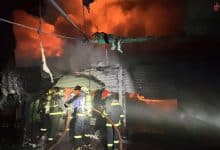Bangladesh: Deforestation leaves Rohingya refugees vulnerable

Days of heavy rainfall have pelted the Rohingya refugee camps in southern Bangladesh, destroying dwellings and sending thousands of people to live with extended families or in communal shelters.
In just 24 hours from Tuesday to Wednesday, more than 30 centimeters (11.8 inches) of rain fell on the camps in the Cox’s Bazar district, which houses more than a million Rohingya refugees. That’s nearly half the average July rainfall in one day.
More heavy downpours are expected in the next few days with the monsoon season continuing for another three months.
Citing initial reports, the UN High Commissioner for Refugees said more than 12,000 refugees had been affected by the heavy rainfall while an estimated 2,500 shelters had been damaged or destroyed.
At least 22 people have been killed in and around the camps over the past three days in the landslides and flash floods caused by the heavy rain. Experts fear more casualties in the coming week as thousands of people still remain in the vulnerable areas.
Why do landslides happen so frequently?
More than 700,000 Rohingya refugees have been living in camps in Bangladesh since August 2017, when the military in Buddhist-majority Myanmar launched a harsh crackdown on the Muslim ethnic group in retaliation to an insurgent attack.
The crackdown included rape, murder, and the torching of thousands of homes. It was defined as ethnic cleansing by rights groups and the United Nations.
Hundreds of thousands of Rohingya refugees were already living in the camps in the hilly areas around Cox’s Bazar, close to the border with Myanmar, for decades before the newcomers arrived.
To accommodate the new refugees in 2017, at least 7,220 hectares of forestland and hills around the existing camps were repurposed, making the area prone to natural disasters.
“Many hills were leveled within a short period to create new camps for the Rohingya refugees. Those hills used to store soil, which soaked up rainwater,” ANM Moazzem Hossain, chairman of the Save the Nature of Bangladesh organization, told DW.
“Makeshift shelters have been made on the sands left after removing the hills, which is very dangerous as rainwater carries sands away and causes landslides as a result,” he added.
“Apart from hill cutting and deforestation across more than 10,000 acres, many deep tube wells were set up in the area to access fresh groundwater for the refugees,” he said, adding: “Excessive use of such tube wells has lowered the groundwater level, which has made the area even more vulnerable to landslide and sinkholes.”
Situation remains dangerous
Abdur Rahman, a local journalist who visited the landslide-prone area recently, noticed that many Rohingya refugees and locals remained in the area despite the risks of further natural disasters.
“Makeshift tents were built on the slopes of hills where the forests had been removed. They can be demolished by landslides at any time during the monsoon season,” he told DW.
Rahman sees a lack of willingness among local authorities to stop illegal deforestation and hill cutting in the Cox’s Bazar area.
“Indiscriminate hill cutting has continued even after the needs of the refugees were met as local authorities don’t work properly to stop it,” Rahman said.
“Rohingya refugees and locals who live in the slopes of the leveled hills need to be relocated to safer places immediately to avoid further catastrophe while strong actions are needed to stop illegal hill cutting,” he added.
Dense population makes relocation harder
Cyclones, heavy monsoon rains, floods, landslides, and other natural hazards are an annual challenge in the camps. While some initiatives have been taken to make the camps safer from natural disasters, experts think nothing much can be done there.
The coastal city of Cox’s Bazar is one of the most disaster-prone parts of the South Asian country. Many rivers crisscross the country, feeding into a delta. The monsoon climate and its location on the Bay of Bengal trigger intense rainfall. The warm sea waters can also generate destructive tropical cyclones.
“We have seen persistent heavy rains over the past few weeks, which is unusual, it’s something I haven’t seen in my entire life,” Hasina Akhter, the Cox’s Bazar area director for BRAC, a humanitarian agency based in Bangladesh, told DW.
Akther described the difficulties associated with creating a safe space for refugees in the overpopulated camps where over a million people live in an area equivalent in size to a third of Manhattan.
“The density of the area is so high that it’s difficult to relocate refugees from one part to other within the camps as there’s not much free space left,” Akther said.
“We have been trying to provide food, fresh water and other things to the victims of the natural disasters. However, more needs to be done. Women and children are suffering a lot,” he added.
The Bangladeshi government has started to move some 100,000 refugees to an island in the Bay of Bengal to reduce some of the pressure on the overcrowded camps in Cox’s Bazar. However, the island, called Bhasan Char or floating island, is also considered by experts to be vulnerable to natural disasters despite the better living conditions and its modern facilities.
SOURCE: DW News
Latest Thailand News
Follow The Thaiger on Google News:


























